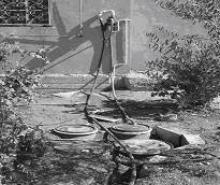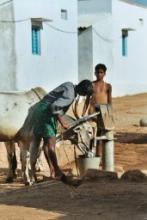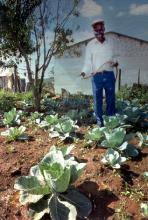Document
INTRODUCTION
Water supply in Jordan is limited, and the lack of new water resources and the level of competition between different water uses like domestic, industrial and agricultural are expected to increase in the near future. Applied research conducted by the Inter-Islamic Network on Water Resources Development and Management (INWRDAM) on decentralized wastewater treatment and use over the last five years has focused on a holistic approach for the development of “state-of-the-art” modular on-site and low-cost greywater treatment and use units at the household level, and implementing capacity building of the local peri-urban communities to enable them to practice sustainable Urban Agriculture (UA). The research focused on optimization of the modular low-cost units for greywater treatment and drip irrigation techniques and crop selection for home gardens. These practises enable saving of freshwater and help safeguard the environment, increase income and strengthen the role of women in the process of proper management of scarce water resources.
Two projects, “Post Project Evaluation of Permaculture Techniques” and “Greywater Treatment and Reuse in HomeGardens” were conducted in the town of Ein Al-Baida, Tafila Governorate, in the southern part of Jordan funded by research grants from the International Development Research Centre, Ottawa, Canada (IDRC). A third project entitled “Community Involvement in Reuse of Greywater to Improve Agriculture Output” was financed by the Jordanian Ministry of Planning and International Cooperation of Jordan (MOPIC). This project benefited more than 800 households in 90 peri-urban sites throughout Jordan providing greywater treatment units and drip irrigation systems.
The aim of this case study is to concentrate on the methods and results of INWRDAM greywater treatment and use.
Technologies
On-site greywater treatment methods developed by INWRDAM were designed with low cost and ease of construction in mind as well as low operation and maintenance costs. They aim to yield greywater of a quality suitable at least for restricted irrigation.
The 4-barrel system
This system is an improvement of the two barrel kit. Two tanks each with 220 liter capacity and filled with gravel media that act as anaerobic filters are inserted between the pre-treatment tank and final storage tanks. The four barrels are lined up next to the other and interconnected with 50 mm PVC pipes.
Once solids and floating material settle in the first barrel, the relatively clear water from the first barrel enters into the bottom of the second barrel. Next the water from the top of the second barrel enters into the bottom of the third barrel. This water passes through the gravel lumps (2-3 cm size graded gravel) and from the top of the third barrel is taken into the fourth. Anaerobic treatment is accomplished in the two middle barrels. Anaerobic bacteria get established on the stone surface so that when the greywater passes through the stones, the bacteria works on breaking down components of the organic material in the greywater. The last barrel acts as a storage tank for treated greywater. As soon as this barrel is filled, a floating device switches on a small water pump which then delivers the water through the drip irrigation network. For an average family home, 20-30 trees (olives, fruit etc) that are planted in the domestic garden can be irrigated.
With a residence time of 1 to 2 days in the 4- barrel treatment kit, the influent greywater undergoes treatment equivalent to between primary and secondary treatment and meets the World Health Organization’s guidelines for restricted irrigation.
The confined trench system
Two plastic barrels and a dug trench filled with gravel media constitute the confined trench system. The first barrel functions as a grease, oil and solids separator and thus acts as a pre-treatment or primary treatment chamber, where the solid matter from the influent greywater settles and the floating components such as grease and soap foam float and can be removed regularly. A trench is dug close to the first barrel with approximate dimensions of 3 meter length, 1 meter width and 1 meter depth. This is lined with an impermeable polyethylene sheet of 400-500 µm thickness. The trench is then filled with 2-3 cm size graded gravel. Pre-treated wastewater from the first barrel enters the bottom part of the trench from one side and follows slowly to the other end. The sides of the side trench are plastered with a mud layer so that the liner sheet is not punctured by sharp stones. A 120 liter capacity plastic barrel is perforated and buried in the gravel at each end of the trench so that treated wastewater flows throughout the trench and upwards to fill this barrel. As soon as this barrel is filled, a floating device switches on a small water pump which then delivers the water through the drip irrigation network. Residence time of greywater in the trench is 2-3 days under anaerobic conditions. The confined trench unit can serve more than one nearby family sharing the same garden plot and it also can deliver more water quantity between pumping cycles.
Results and discussion
This project resulted in many direct and indirect benefits to the community and the environment. Women in the community benefited most from this project through training workshops, dialogue and learning-by-doing and acquired new skills to build a productive garden. The monthly domestic water consumption decreased by about 30% for all greywater users and income of the poor increased on the average by US$50 to US$ 150 per month. Many beneficiaries no longer had to pay a large portion of their monthly income for emptying their septic tanks. Many families started to copy and imitate the practice of their neighbours with respect to greywater use.
INWRDAM has also succeeded in promoting similar greywater activities in other Islamic countries, such as Lebanon, where greywater reuse is being adopted in a cluster of six towns. More projects addressing grey water use are now being implemented in Jordan, Palestine and Lebanon with an emphasis on conserving fresh water, improvement of sanitation and generating extra income for the poor in peri-urban areas and promoting sustainable urban agriculture practices. A recent evaluation of INWRDAM greywater projects by an external evaluator indicated that: “INWRDAM has contributed to raising the profile of greywater use both in Jordan and in other parts of the world”.
Recommendations for further work
The following recommendations can be made regarding the appropriateness of greywater use technologies:
- The scheme or technology should be a felt priority in public or environmental health, and both centralized or de-centralized technologies should be considered
- technology should be low-cost and require low energy input and mechanization which reduces the risk of malfunction
- technology should be simple to operate, be locally labour intensive, be maintained by the community, and not rely on expensive chemical inputs such as chlorine or ozone to meet quality guidelines
- treatment should be capable of being incrementally upgraded as user demand or quality standards and treatment guidelines increase.
References
Bino, J. Murad and Al-Beiruti, S. Greywater Treatment And Reuse Project, Tafila, Jordan (2000-2003). Conducted by the Inter-Islamic Network on Water Resources Development and Management with financial support from the International Development Research Centre (IDRC).
Author
Shihab Al-Beiruti, Head of Services and Programs Section, The Inter-Islamic Network on Water Resources Development and Management (INWRDAM), PO Box 1460, Jubieha-Amman, 11941, JORDAN (shihabinw@nic.net.jo)
It has been argued (see for example the book Beyond Domestic) that productive uses of ‘domestic’ water can lead to improved financial sustainability. Household water users may be more likely to be able and willing to pay water charges when they are cultivating gardens or keeping some livestock as well as consuming water for normal domestic purposes.
In March 2005, IRC undertook a study to assess the financial sustainability of water supply systems for five municipal Autonomous Water and Sanitation Companies (SAAS) on Santiago Island in Cape Verde. Some wellfields here are used to supply water for domestic consumption as well as water for irrigated agriculture around the towns, and the water companies manage supply for both users. But the water companies do not recover enough water fees to cover costs and currently they face serious problems of financial sustainability. The main reason for this situation is a subsidised tariff for irrigation water, which is much lower than production costs that the water companies have to bear. Furthermore the water companies face an additional problem: decentralised government institutions have large outstanding debts owing to the water companies.
The tariffs for irrigation are maximum CVE15/m3 (USD 0.17) for traditional irrigation and CVE8/m3 (USD 0.09) for farmers using drip irrigation. These rates are established by the Ministry of Agriculture as an incentive for agricultural production and are beyond the direct control of the water companies. However, the average cost of production per m3 to the water companies is much higher: between CVE37/m3 and CVE110/m3 (0.42 - 1.24 USD respectively). This difference is paid for by drinking water consumers. The burden falls disproportionately on those who pay the highest prices per m3: poor consumers who rely upon water provided by tankers and fountains. Effectively, the poorest in the towns are subsidising the low price of water for irrigation. But the water companies do not have enough drinking water consumers to cover the “hole” in their accounts created by the sale of water for irrigation. Each month, the financial deficit of the water companies grows worse. To make the situation more complex, a poverty analysis shows that the small towns with the highest percentage of extreme poverty (where income is less than CVE 2.403 (27 USD) per capita per month), have the largest irrigation areas. In some cases, the minimum monthly domestic water tariff reaches up to 21% of the income of the poorest.
In this case, due to the way in which tariffs are set, productive use for irrigation from a multiple use water supply is leading to serious problems of equity and financial sustainability which threatens to undermine the entire system.
For more information contact Catarina Fonseca at fonseca@irc.nl The book Beyond Domestic: Case studies on poverty and productive uses of water at the household level (Eds. Moriarty, P., Butterworth, J., & van Koppen, B.) is available from publications@irc.nl with reduced rates available for organisations in the south.
A recent book addresses some of the problems caused in rural India by a narrow focus on water for drinking. An extended quote from the book makes interesting reading:
“The rationale for Unicef's agreement to support the 'accelerated' rural water supply programme is very significant. The thrust was safe drinking water, to pursue the goal of improved public health particularly of children. In spite of the needs of the Indian farmer for water to irrigate his crops during the dry season, without which his family's food supply would be threatened and children's and women’s' well-being jeopardized from another direction, Unicef's concern was limited to water for drinking and domestic purposes. Indeed, if there had been any mention of agriculture during the debates surrounding the proposal, it would have stopped dead in its tracks. Some advocates of applied nutrition were keen to support domestic water supplies for kitchen gardens as an adjunct of family food supplies, but nutrition programmes were then seen as an adjunct to health in the Unicef perspective. This did not accord with the way community water resources were traditionally viewed, either by villagers or by previous government policy.
Given their multiple needs for water, including water to irrigate their crops, villagers in India tend to view the water resources available to them holistically. What they need is water, plain and simple. In many parts of the country little differentiation is made between water for drinking and domestic purposes and water for cultivation. Certain wells and other sources may be favoured for drinking because of their taste or perceived purity, or because they can be more conveniently accessed. Until the advent of the 'problem village' with its exclusive focus on defining water scarcity in terms of water for drinking, government programmes for village water supply had not made this distinction either. But in the late 1960s, influenced on the one hand by the Green Revolution and its emphasis on large-scale irrigated agriculture, and on the other by a new 'water for health' ideology promoted by Unicef and WHO, government policies towards water were for the first time compartmentalized.
The long-term implications of this division along sectoral lines were not then perceived but they were to be profound. In fact the idea that they were promoting a departure from the norm did not occur to Unicef, whose new water professionals were schooled in Western public health engineering traditions, where domestic water supplies have no livelihood context and are almost exclusively about washing, cooking and drinking. No one can quarrel with the primacy of water for drinking. Water to drink is indisputably essential for human and livestock survival. But a policy which neglected other basic water needs, and failed to integrate requirements for agriculture and requirements for health has become, in more recent times an albatross of terrifying proportions. Such a crisis has not been anticipated at the time. There was a head of political steam behind village drinking water supplies, and after initial self-doubt, Unicef stood ready to serve.”
Read more in Black, M., Talbot, R. 2005. Water a matter of life and health, water supply and sanitation in Village India, Unicef with Oxford University Press, New Delhi. The above quote is from pages 41-43.
Included in the strategy published in September 2004 is the following discussion on water for productive livelihoods:
'"The objectives of the [National Water] Act are, among other things, to meet the basic human needs of present and future generations, to promote equitable access to water, and to redress the results of past racial and gender discrimination. The Department is committed to achieving these objectives, and particularly to ensuring that water management strategies contribute to the eradication of poverty.
Although significant progress has been made in addressing the backlogs in water services, the provision of water to meet basic human needs does not make allowance for water for income-generating activities.
Similarly, whilst prioritising allocations of water for emerging farmers and small grower forestry schemes, and revitalising defunct irrigation schemes has the potential to provide livelihoods for many people in rural areas, these do not address the needs of the large numbers of people who require water for small-scale activities such as, for instance, brick making, rearing poultry and growing produce for local sale. The quantities of water required are relatively small - research in small villages indicates that livelihoods can be significantly enhanced by the availability of 50 to 100 litres per household day.
Although Schedule 1 provides for the use of small quantities of water without the need for further administrative authorisation it is restricted to domestic uses such as food gardens and domestic stock watering. As the Act currently stands water use under Schedule 1 supports subsistence activities but does not allow water to be used for commercial purposes.
The requirements for water for small-scale uses in rural areas will be quantified during compulsory licensing (see below), and the Department will investigate ways of making secure and cost effective supplies of water available without placing unnecessary administrative burdens on the users.
The requirements for water need not necessarily be met via piped supplies or using water abstracted from rivers. Rainwater harvesting from roofs or other hardened surfaces, using tanks, small check dams or catchpits can supplement more conventional sources of supply, and more use can be made of groundwater. Soil moisture can be retained on cultivated land and infiltration can be increased by contouring or constructing other micro water retaining structures, which have limited effects on water resources or downstream users.
The Department will work closely with other government agencies, particularly agricultural extension services, and in partnerships with non-governmental organisations and the private sector to explore possible options and ensure that appropriate interventions are implemented.''



